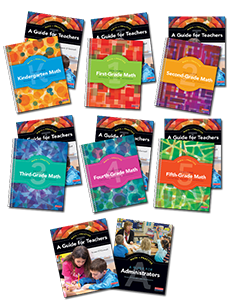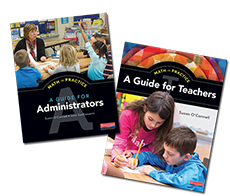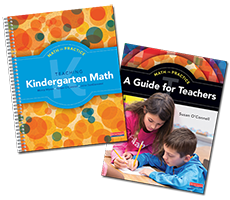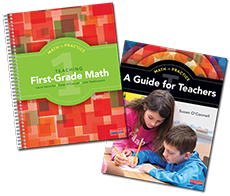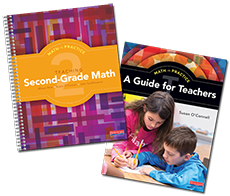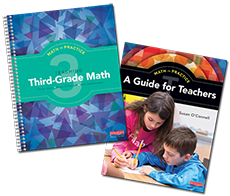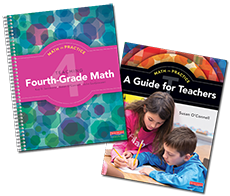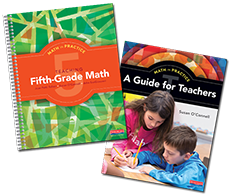Teaching and learning math can be hard. Math in Practice is like a math coach for every teacher. This grade-by-grade resource is filled with strategies and support for teaching math more confidently and effectively.
-
Overview


Math in Practice is a standard-based, professional learning resource from Sue O'Connell and colleagues. This grade-by-grade K–5 resource fits with any math curriculum you are using. It identifies the big ideas of math content and best-practice teaching, unpacking essential teaching strategies and detailing why those strategies are powerful.
Math in Practice is not another curriculum; it’s professional development in a book! It supports teachers, administrators, and entire school communities as they:

Guide students into deeper math understanding
Respond to the challenges of their math curriculum
Support students who are struggling, excelling, and anywhere in between -
Grade-Level Books
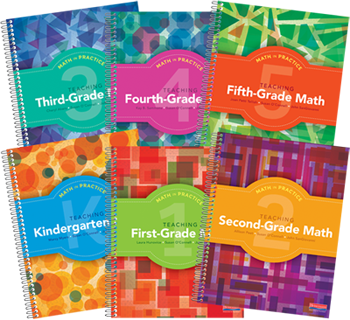
Each grade-level book is organized into modules that carefully unpack the specific math content taught at each grade, K–5. Rather than being used in order, teachers can select modules as needed based on their curriculum map, areas of instructional focus, or reteaching needs.
Every module provides:
- insights about the key math ideas
- teacher notes highlighting approaches for promoting student understanding
- a wealth of classroom tasks and activities illustrating the specific strategies
- an extensive collection of corresponding online resources
Click below to see the full list of modules in each grade-level book:
Counting and Cardinality: Numbers 1–5
Counting and Cardinality: Numbers 0–10
Counting and Cardinality and Place Value: Numbers 0–20
Counting Numbers
Comparing Numbers 1–10
Decomposing Numbers
Understanding Addition
Understanding Subtraction
Understanding Facts
Exploring Measurement
Sorting and Classifying Objects
Introducing Geometry
Exploring GeometryAddition Word Problems with Sums to 20
Connecting Subtraction and Addition to Solve Word Problems
Math Fact Understanding and Fluency: Expanding on +/-1, +/-0
Math Fact Understanding and Fluency: +/-2
Add and Subtract +/-10
Add and Subtract Doubles
Making Ten
Counting and Understanding Place Value
Exploring Addition and Subtraction with a Two-Digit Number
Measuring Lengths with Indirect Comparisons
Telling Time to the Hour and Half Hour
Working with Money
Represent and Interpret Data
Understanding and Describing Shapes and Defining Attributes
Partitioning Shapes into Halves and FourthsProblem Solving
Math Fact Understanding and Fluency
Foundations for Multiplication: Equal Groups
Place Value
Compare Two Three-digit Numbers
Understand Multi-digit Addition
Understand Multi-digit Subtraction
Extend Understanding of Multi-digit Addition
Extend Understanding of Multi-Digit Subtraction
Length Measurement
Time
Money
Represent and Interpret Data
Describing Geometric Shapes
Partition ShapesUnderstanding Multiplication and Division
Understanding Properties of Multiplication and Division
Fluently Multiply and Divide
Solving One- and Two-Step Problems with All Four Operations
Rounding Numbers to the Nearer Ten or Hundred
Fluently Add Within 1,000
Fluently Subtract within 1,000
Understanding Fractions and Fraction Notation
Fraction Equivalence
Comparing Fractions
Time
Mass and Volume
Represent and Interpret Data
Understand the Concept of Area
Perimeter
Understanding and Describing ShapesUnderstanding and Solving Problems with Multiplicative Comparison
Factors, Multiples, and Prime and Composite Numbers
Understand the Place Value System
Fluently Add and Subtract Multi-digit Numbers Using the Standard Algorithm
Use Place Value to Perform Multi-digit Multiplication
Use Place Value to Perform Multi-digit Division
Equivalence and Ordering of Fractions
Adding and Subtracting Fractions with Like Denominators
Multiplying Fractions by Whole Numbers
Understand Decimal Notation for Fractions
Measurement and Measurement Conversions
Area and Perimeter
Represent and Interpret Data
Geometry and Geometric Measurement
Solving Complex ProblemsPlace Value
Write and Interpret Numerical Expressions
Multiplying with Multi-Digit Numbers
Division with Multi-Digit Whole Numbers
Addition and Subtraction of Decimals
Multiplication and Division with Decimals
Adding and Subtracting Fractions with Unlike Denominators
Fractions as Division
Multiplication of Fractions by Fractions and Whole Numbers
Division with Whole Numbers and Unit Fractions
Converting Like Measurement Units
Represent and Interpret Data
Geometric Measurement: Exploring Volume
The Coordinate System
Classify Two Dimensional Figures -
Guide for Teachers
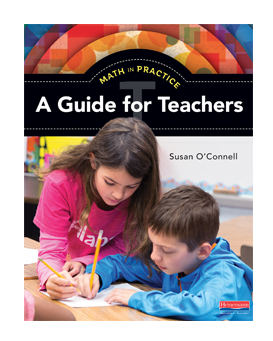
The Guide for Teachers lays out big ideas in best-practice math instruction, including topics such as math talk, modeling, and differentiation.
Topics addressed include:
- Asking questions that stimulate student thinking
- Making sense of and connections between mathematical ideas
- Using representations and models effectively
- Helping students communicate about math
- Learning from meaningful formative assessment
-
Guide for Administrators
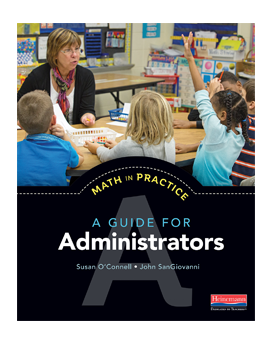
The Guide for Administrators helps principals, coaches, and other leaders know what to look for in effective math classrooms and how to support teacher growth.
Topics addressed include:
- The importance of ongoing professional development
- What to look for in the “new” math classroom
- How to support teachers and promote effective instruction
- Ideas for intervention and assessment across an entire school
- Support for working with parents



 Facebook Group | MIP
Facebook Group | MIP



